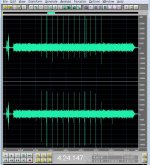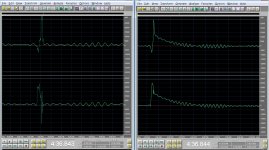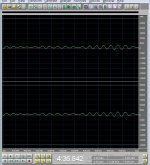Since my old turntable/cart died, I have been willing to entertain new there, though... B&O 4002 with Sonus Blue cart was quite good in the day.
B&O 4002 was/is one of the finest TTs but it’s arm accommodates only B&O MMC series cartridges. How did you install the Sonus Blue there?
My reading of that paper is that you may need 17-19 bits to get 16 bits worth of resolution, especially if you like Bob Marley's music. That is not too different from my wild guess of 20 bits.
That paper says that with digital RIAA you need to lose in exceptional cases (BM&W) 3.1 bits and in non exceptional cases 2.2 bits, far less from the anticipated 7.4 bits for the 40dB of decompensation.
That loss is less than the bits you have to reserve if you digitize an already analog RIAA decompensated signal.
Another take-away from this paper is that if declicking is desirable, it would better be performed prior to applying the digital RIAA decompensation.
Thank you Scott for re-providing the link to this paper.
I would like to have an opinion on the two issues (2 bottom lines with the asterisks) in post #2
George
S/N issues
George,
Thanks for starting this thread. Regarding S/N and perceptibility: a single S/N number representing the sum of all energy in the passband being measured does not give the actual energy at any one given frequency, or subset of frequencies. In these the energy is much lower. A few years ago, in an effort to see how many bits would be needed to accurately encode music to equal the fidelity of a Dolby C cassette, I performed a series of tests on this exact issue and found that with a measured DIN 70dB S/N, single tones can be heard and seen in a spectrum analyzer at -105-110dB below reference. Noise shaping and the frequency being observed will obviously affect this result. It would be very interesting to perform this experiment with digital RIAA eq and see what results.
Given this data, I believe your 24 bits is sufficient except for one issue: clicks and pops. I remember an article which showed these can cause cartridge output 20dB or more above reference level. I cannot remember where that was, an old issue of Audio I believe. Addressing the behavior of an A>D during these events is beyond my pay grade. I will say the Apogee A>Ds I have used seemed to handle overload much more gracefully than the Sonys commonly used.
Just my $0.02 worth
Cheers,
Howie
Howard Hoyt
CE - WXYC-FM 89.3
UNC Chapel Hill, NC
WXYC Chapel Hill, North Carolina - 89.3 FM
1st on the internet
Now, minimum noise level for vinyl is around –70dB rel 0dB @ 8cm/s [Burkhard Vogel “The Sound of Silence” 1st Ed, Fig 3.95] The Sound of Silence - Lowest-Noise RIAA Phono-Amps: | Burkhard Vogel | Springer
There is an opinion that we (they) are able to hear sound signals which are buried in the noise.
If this is correct, we should target for a signal 20dB below the noise floor of vinyl.
We end for the minimum (lowest) music signal to be at –90dB rel 0dB @ 8cm/s.
This is equivalent to 0.00025cm/s and translates to different voltage level at the output of a cartridge. See Table 2 (att2)
George,
Thanks for starting this thread. Regarding S/N and perceptibility: a single S/N number representing the sum of all energy in the passband being measured does not give the actual energy at any one given frequency, or subset of frequencies. In these the energy is much lower. A few years ago, in an effort to see how many bits would be needed to accurately encode music to equal the fidelity of a Dolby C cassette, I performed a series of tests on this exact issue and found that with a measured DIN 70dB S/N, single tones can be heard and seen in a spectrum analyzer at -105-110dB below reference. Noise shaping and the frequency being observed will obviously affect this result. It would be very interesting to perform this experiment with digital RIAA eq and see what results.
Given this data, I believe your 24 bits is sufficient except for one issue: clicks and pops. I remember an article which showed these can cause cartridge output 20dB or more above reference level. I cannot remember where that was, an old issue of Audio I believe. Addressing the behavior of an A>D during these events is beyond my pay grade. I will say the Apogee A>Ds I have used seemed to handle overload much more gracefully than the Sonys commonly used.
Just my $0.02 worth
Cheers,
Howie
Howard Hoyt
CE - WXYC-FM 89.3
UNC Chapel Hill, NC
WXYC Chapel Hill, North Carolina - 89.3 FM
1st on the internet
As Scott pointed out some time back, you don't want to replicate the tick or pop with high fidelity, just recover quickly from it. For MM carts I have to say I find the Bob Cordell 'damped eq' approach potentially of interest as you roll off the treble response electrically before you even get to the amplifier.
Yes, that’s best done at the pre-amp level. Before A/D designers figured out some solutions clamp-amps were a viable product, mainly because some A/D’s were on lower supplies and broke badly if a transient went outside the rails. Here are some pictures showing what I have observed with even some of the cheaper pieces of hardware. This is a Tascam DR60D recording band 25 on an old Telarc Omnidisk (1kHz 1/3 octave noise) with an unfortunate scratch. The second picture shows the first pop isolated where the upper channel clips, left is unequalized and right shows that after minimum phase RIAA you get basically a copy of the impulse response of the equalization. The point here is that extending the pop above clipping would only increase the area of the result but keep essentially the same shape i.e. the same sound only slightly louder. This of course is if the pre-amp does not stick at the rail, invert phase, etc. I see the Channel D folks are now recommending the Scarlet 2i2 USB soundcard, thanks to Jan I got one of those too. A problem with some of these devices is that line in is not differential and the differential mic preamps are 1-2k input load so a simple adapter is not a solution for MM/MI if you want to go differential. Also the noise performance/gain on the line in might not be a good fit.
Now notice that the equalization spreads the effect of what is ~1msec of lost track across a few msec of program. So this is another reason why the removal is best before equalization. The third picture is ClickFix in force fix mode where (you need to experiment at first to get it right) you select just enough program to get a near perfect repair. It seems to be some algorithmic thing in that trying to repair an entire track does not fix these really big pops as well. Usually there are only 20 or 30 bad clicks on records that I have chosen to keep. Obviously restoring badly scratched LP’s is a labor of love or money if you buy something like CEDAR.
Real time pop removal would require a different tool which I have not evaluated, or the easiest thing if I chose to do it would be to write it in C and use SoX in a pipeline. I don't have any interest in writing VST or any other standard plug-ins.
Now notice that the equalization spreads the effect of what is ~1msec of lost track across a few msec of program. So this is another reason why the removal is best before equalization. The third picture is ClickFix in force fix mode where (you need to experiment at first to get it right) you select just enough program to get a near perfect repair. It seems to be some algorithmic thing in that trying to repair an entire track does not fix these really big pops as well. Usually there are only 20 or 30 bad clicks on records that I have chosen to keep. Obviously restoring badly scratched LP’s is a labor of love or money if you buy something like CEDAR.
Real time pop removal would require a different tool which I have not evaluated, or the easiest thing if I chose to do it would be to write it in C and use SoX in a pipeline. I don't have any interest in writing VST or any other standard plug-ins.
Attachments
Last edited:
Surgery... I had a spare arm, which I cut and fashioned a socket for the Sonus pins out of balsa and epoxy. It worked just fine for many years, until the wires gave out, and I was too fumble-fingered to get it working again.B&O 4002 was/is one of the finest TTs but it’s arm accommodates only B&O MMC series cartridges. How did you install the Sonus Blue there?
I think you will need around 20 bits genuine resolution just to capture the input signal from the cartridge. That probably means a 24 bit ADC with a dynamic range of around 120dB - such devices may now exist, although most audio 24-bit ADCs seem to be more like 110dB. If the record is imperfect you may need some extra headroom to accomodate clicks. All this assumes that the dynamic range of the ADC is closely aligned to the dynamic range of the cartridge and vinyl, so you will either need more bits or a variable gain flat preamp.
Alternatively use an analogue RIAA preamp with a 16-bit ADC.
AK5394A https://www.akm.com/akm/en/file/datasheet/AK5394AVS.pdf
THD+N 110 dB
S/N 123 dB
Dynamic range 123 dB
In my tests, in some conditions, all the harmonics are lower that -120 dB.
This chip has been available since around 2004? Its used in a number of premium recording chains.
There are others which have potentially greater DR but higher distortion.
I don't think the ADC needs to be a roadblock.
Scott-
Would an ADAU1452 ADAU1452 Datasheet and Product Info | Analog Devices run your eq algorithms? I don't remember how adaptable the Sigma DSPs are but it would seem this chip could handle it all. (maybe even a click-fix?) I have not fired up Sigma Studio in a year or so so I don't know if you can load custom stuff but I think its possible.
Would an ADAU1452 ADAU1452 Datasheet and Product Info | Analog Devices run your eq algorithms? I don't remember how adaptable the Sigma DSPs are but it would seem this chip could handle it all. (maybe even a click-fix?) I have not fired up Sigma Studio in a year or so so I don't know if you can load custom stuff but I think its possible.
Found the chip. THAT1580. Of course it comes in the 16 pin QFN package only.My SM soldering skills are rusty.
I am same. Differential chip Yay. QFN16 boo
Scott-
Would an ADAU1452 ADAU1452 Datasheet and Product Info | Analog Devices run your eq algorithms? I don't remember how adaptable the Sigma DSPs are but it would seem this chip could handle it all. (maybe even a click-fix?) I have not fired up Sigma Studio in a year or so so I don't know if you can load custom stuff but I think its possible.
Yes, presumably a firmware change to a miniSHARK could do everything.as well as your crossovers. I have not found any open source pop removal code, maybe some one like the ClickFix guy could be convinced to contribute. Certainly if it was going to be a one box commercial product some one would come forward on a royalty basis.
I am same. Differential chip Yay. QFN16 boo
https://www.youtube.com/watch?v=c_Qt5CtUlqY
A USB microscope can help.
EDIT- This comment made me laugh "Nicely done vid. I have confirmed I won't be doing this."
Last edited:
Now, minimum noise level for vinyl is around –70dB rel 0dB @ 8cm/s [Burkhard Vogel “The Sound of Silence” 1st Ed, Fig 3.95] The Sound of Silence - Lowest-Noise RIAA Phono-Amps: | Burkhard Vogel | Springer
There is an opinion that we (they) are able to hear sound signals which are buried in the noise.
If this is correct, we should target for a signal 20dB below the noise floor of vinyl.
We end for the minimum (lowest) music signal to be at –90dB rel 0dB @ 8cm/s.
This is equivalent to 0.00025cm/s and translates to different voltage level at the output of a cartridge. See Table 2 (att2)
I think that's about right. However, if only cutting engineers stuck to spec limits ! In practice +15dB @ 1kHz ref 8cm/s sort of levels won't often be exceeded by programme material IME.
So this gives a dynamic range requirement of about 105dB plus a bit for luck, I think. Plus a means of limiting pop noise events that can exceed peak levels.
LD
I have backed this project:
https://www.kickstarter.com/project...lder-paste-and-fluids-dispenser?ref=user_menu
A suitable oven with programmable temp profile is about 300 bucks. After that, you can solder anything!
Jan
https://www.kickstarter.com/project...lder-paste-and-fluids-dispenser?ref=user_menu
A suitable oven with programmable temp profile is about 300 bucks. After that, you can solder anything!
Jan
- Status
- This old topic is closed. If you want to reopen this topic, contact a moderator using the "Report Post" button.
- Home
- Source & Line
- Analogue Source
- Digitizing vinyl


